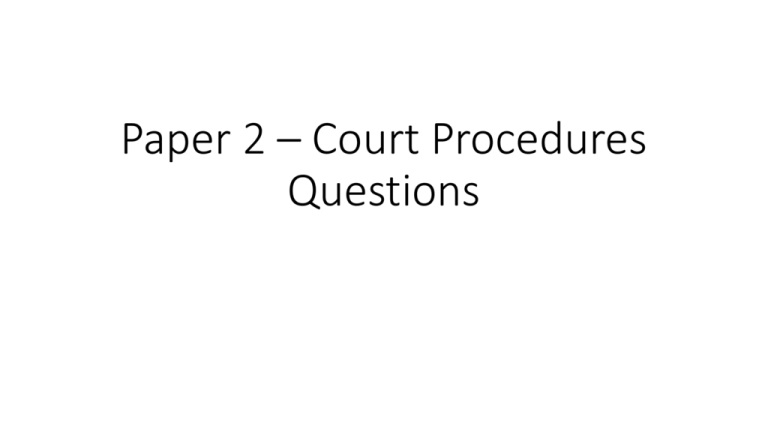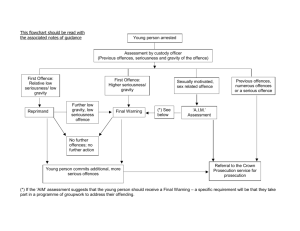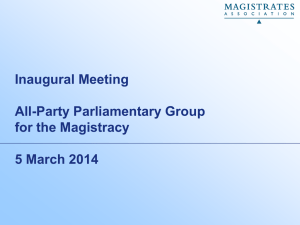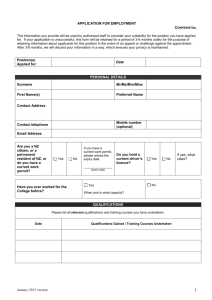File - Social Sciences
advertisement

Paper 2 – Court Procedures Questions Possible Questions • Court Procedures: • Outline the procedural differences between an either-way and an indictable offence and briefly explain how this would apply to X (5) • Outline the pre-trial procedure which would be followed if X was to be charged with a summary offence (5) • Sentencing: • Assume X has been convicted of an offence. Discuss the factors that the court would consider before deciding on X’s sentence (8) • Assuming X is convicted of an offence, briefly outline the factors which the court would take into account before X is sentenced (5) • Assume X has been convicted of an offence. Outline the factors that the court would take into account when considering the sentence and outline the range of sentences available to the court (8) • Outline the aims of sentencing and briefly discuss how these aims might apply if X were to be convicted of any offence (5) • Assume that X has been convicted of S.47. Outline the range of sentences that would be available to the court (5) • Briefly explain the aims of sentencing and outline the range or sentences available to the court if X was convicted of any offence Outline the procedural differences between an either-way and an indictable offence… Either Way Offences Either-way Offences – can be tried in either Magistrates’ Court or Crown Court – e.g. S.47 and S.20 Offences Against the Persons Act 1861 1. First hearing at MC – D enters a plea 2. If not-guilty – Magistrates to decide whether they are able to deal with the case themselves (Mode of Trial) 3. If they decide they are unable to deal with it, the case is sent to CC 4. If they decide they can deal with it, D can decide to go before the CC. It will either be sent to CC for trial or remain at MC where it will proceed to trial depending on D’s decision 5. If D pleads guilty, magistrates decide whether or not they have the power to impose an appropriate sentence – if not they send to CC for sentence Indictable Offences Indictable Offences – most serious offences , e.g. S.18 OAPA. Must be tried in Crown Court (judge and jury) 1. First hearing in MC – charge read out, but D not required to enter a plea until he appears at CC. Magistrates send case to CC 2. If D pleads guilty at CC, judge may sentence there and then, or may decide that a pre-sentence report is needed and will adjourn the case for about a month. 3. If D pleads not guilty, case is adjourned for a date for trial. …and briefly explain how this would apply to X (5) Offence Type Court Assault Summary Magistrates’ Battery Summary Magistrates’ S.47 Offences Against the Persons Act 1861 Either-way Magistrates’/Crown S.20 Offences Against the Persons Act 1861 Either-way Magistrates’/Crown S.18 Offences Against the Persons Act 1861 Indictable Crown Outline the pre-trial procedure which would be followed if X was to be charged with a summary offence (5) 1. First hearing at MC: • D may be represented by a duty solicitor if he does not have or has not requested a named solicitor • Charge put to D and D enters a plea • If D enters a guilty plea, Magistrates may sentence there and then, or they may decide to order a pre-sentence report – if they decide they need a pre-sentence report, case is adjourned for 3-4 weeks • If D enters not-guilty plea, either a trial date will be fixed there and then, or else the case will be adjourned for a period of weeks for a pre-trial review • Magistrates may grant a Representation Order to cover D’s representation by a solicitor 2. Pre-trial review (if there is one) – magistrates fix a date for the trial taking into account the availability of the witnesses and likely length of the trial 3. Between each hearing, Magistrates will decide on bail: • If bail granted – D released from custody until the next date when he must attend court • If bail refused, this will be because the court believed D, if released on bail, will abscond (not turn up), commit an offence, interfere with witnesses, or interfere with the criminal justice process • Conditional Bail - court can impose requirements which are necessary to make sure D attends court and does not commit offences or interfere with witnesses while on bail • Unconditional Bail - If court thinks D is unlikely to commit further offences, think he will attend court as required, and will not interfere with justice process, he will usually be released on unconditional bail 4. Trial at Magistrates’ Court Assume X has been convicted of an offence. Discuss the factors that the court would consider before deciding on X’s sentence (8) • What is the maximum penalty available (also link to trial venue if it is either way offence) Offence Maximum Sentence Assault 6 months imprisonment/fine Battery 6 months imprisonment/fine S.47 Offences Against the Persons Act 1861 5 Years imprisonment S.20 Offences Against the Persons Act 1861 5 years imprisonment S.18 Offences Against the Persons Act 1861 Life imprisonment • Criminal Justice Act 1991 sentencing must be proportionate to the seriousness of the crime • S. 142 Criminal Justice Act 2003 –judges and magistrates must have regard for the following purposes of sentencing: • • • • • The punishment of offenders The reduction of crime (including reduction by deterrence) The reform and rehabilitation of offenders The protection of the public The making of reparation by offenders to persons affected by their offences Assume X has been convicted of an offence. Discuss the factors that the court would consider before deciding on X’s sentence (8) • D’s previous convictions are made available to judge/magistrates • Judge/magistrate will consider pre-sentence report if there is one • Aggravating factors – may suggest a higher sentence is appropriate • • • • • Targeting a particularly vulnerable victim Racial or other discriminatory motivation Use of a weapon Repeated blows Unprovoked attack • Mitigating factors – may suggest a lower sentence is appropriate • • • • • • Having been provoked Showing immediate remorse D’s age D’s disabilities Early guilty plea Co-operating with police • Apply to facts of the case Outline the aims of sentencing and briefly discuss how these aims might apply if X were to be convicted of any offence (5) • S.142 Criminal Justice Act 2003 – requires judges and magistrates to have regard for: • The punishment, reduction of crime, reform and rehabilitation, protection of the public, reparation by offenders • Retribution - Based on the idea of revenge. Many individuals, and often society as a whole, feel better that someone has gone to prison for a long time • Deterrence • Individual deterrence - Where the sentence is designed to make the offender not wish to reoffend for fear of suffering the same or worse punishment • General deterrence - Where the prospect of potential punishment dissuades most people from offending • Prevention of Crime - Protects the public • Rehabilitation - Offering offenders help to overcome problems that they face, attempting to make it easier to avoid future offending • Apply to facts Assume that X has been convicted of S.47. Outline the range of sentences that would be available to the court (5) • Give the maximum sentence of the offence D has been convicted of • Custodial Sentences - Most serious sentence, reserved for the most serious crimes. The sentence represents the maximum amount of time the offender will remain in prison • Prison sentence can be suspended – sentence will not take effect unless there is a subsequent offence within a specified period of time • Community Sentences - Combine punishment with changing the offender’s behaviour and making amends • Compulsory (unpaid) work – Offender works up to 300 hours on local community projects e.g. cleaning up graffiti • Programmes – aimed at changing offender’s behaviour e.g. anger management • Curfew – offender must be at home at certain times. Usually wear an electronic tag on wrist or ankle to notify monitoring services if he is absent during those hours • Drug treatment and testing, alcohol treatment • Supervision – offender required to attend appointments with an Offender Manager from Probation Service • Financial Sentences - Can be a fixed penalty e.g. fixed penalty speeding fine. Or can be given subject to a statutory maximum for the offence • Compensation orders – these are different to fines as they are paid to the victim rather than the state and is designed to repay the victim e.g. for damage to property • Discharge: • Absolute Discharge – court decides to take no further action against an offender, but the discharge will appear on the offender’s criminal record • Conditional Discharge – D is convicted without sentence on condition that he does not re-offend within a specified period of time – can be between 6 months and 2 years. If another offence is committed during this time, the court can look at the old offence as well as the new one in deciding the sentence to impose






